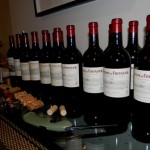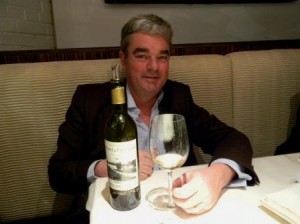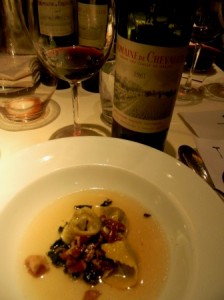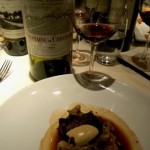UPDATE: 16 vintages of Domaine de Chevalier in Washington D.C.
June 12, 2011
UPDATE: Coverage by The Washington Post, HERE, thanks to Dave McIntyre… an article that was published in late March 2011, but I only discovered it yesterday. Thanks to Dave for the kind review and also for the link to the decanter.com coverage.
THE VIDEO – See text and photos below
Dating back to at least the 17th Century, Domaine de Chevalier is a jewel in the Bordeaux crown. It produces some of the very best wines of the Graves region and perhaps the best white wine of Bordeaux. Producing both red and white wines, Domaine de Chevalier – located in Leognan – enjoys an interesting microclimate, surrounded by forest.
Since 1983, Olivier Bernard has owned and run the estate. Much has been done to improve the quality of the wines. And while the whites had always been appreciated, he has – along with Remi Edange and a faithful crew – improved the red wines and maintained the high quality of the whites. So much so that red Domaine de Chevalier has become a benchmark for a fresher, more classical style of Bordeaux, never over-rich or overdone.
It was thus very interesting to see how a group of sommeliers, restaurateurs, wine merchants and wine lovers evaluated 10 vintages of red Domaine de Chevalier: 2009, 2008, 2007, 2006, 2005, 2004, 2003, 2002, 2001 and 2000, followed by lunch with three more reds (1991, 1981 and 1961) as well as three whites (2001, 1991 and 1981). The event took place on Saturday 29 January. Most everyone came away impressed with the wines.
The white has always enjoyed a great reputation. It is perhaps surpassed by the whites of Haut Brion and La Mission Haut Brion (formerly known as Laville Haut Brion), and can be rivaled in some vintages by the whites of Pape Clement and Smith Haut Lafitte. I do not have the vast experience of other Bordeaux wine lovers, but since tasting en primeur in 2003, I note that the whites of Domaine de Chevalier are generally the most crisp and precise of all the wines tasted blind in tastings organised by the Union des Grands Crus de Bordeaux, which do not include Haut Brion and Laville Haut Brion. These latter two tend to have more opulence, but are no better in terms of precision and focus. And longevity. Domaine de Chevalier whites tend to last a very long time. One fine memory was a blind tasting in 2010 of the 2000 vintage. While that vintage proved generally excellent for reds, it was not quite as good for whites, which have a tendency to be a bit flabby. Not so Domaine de Chevalier, which revealed itself to be very firm and fresh and with the longest lasting potential.
The tasting and lunch took place at Black Salt, a well known Washington D.C. restaurant known for its fish and seafood, but also capable of offering fine meat-based dishes. Many thanks to Mark Wessels of MacArthur Beverages for assuring safe passage and stocking of all the bottles, which were sent directly ex-chateau for the tasting. Mark also helped out with decanting and serving the wine! Participants included various wine bloggers in the Washington D.C. area; Dave McIntyre, wine writer for the Washington Post; Maria Denton, sommelier and director of the Society of Wine Educators; Kathryn Morgan, sommelier of the celebrated Citronelle Restaurant; Ben Giliberti, Education Director of Calvert Woodley Imports and many others.
Owner Olivier Bernard is a wine lover and is very passionate about what makes great wine. Much was said about the importance of patience in the vineyard, obtaining optimal maturity yet maintaining excellent acidity, reduction as opposed to oxidation when it comes to aging wine in bottle, about wine-food pairings, about winemaking styles and viticulture. Bernard engaged his audience with information and his methods of winemaking, including paying extra for harvesters to come at the last minute. By the time the tasting and lunch ended – we started about 11.20 am and ended things about 4 pm – we all came away feeling warm on a cold, January day at the nation’s capital.
I was pouring a lot and did not get as much a chance to sit down and note my impressions of every wine tasted, but here – from memory – my notes, using the Decanter five-star rating system, express an opinion as to how the wine is drinking today, although its ultimate potential is qualified with “going on”. The 10 red vintages were served in flights of three, starting with the oldest wines, and then we enjoyed the 2009 alone as a barrel sample. Red and bold means a wine I really loved.
First flight: 2000-2001-2002
2000 red: This wine was full bodied and despite decanting, it needed time in glass to open up. Though not primary, it was far from ready to drink, in my opinion. Much potential, perhaps big in some respects, but also containing superb aromatic complexity that is not yet expressing itself optimally in glass. It will certainly gain from more time in bottle. 4 stars going on 5
2001 red: Here we have a wine that is more open than the 2000, with a bit more elegance on the palate and yet not quite as much body. A lovely, rather herbal and olive expression, also some red fruit aspects, but just a tad closed, again despite double decanting (Olivier had asked me to double decant just the 2000 and 2001 among the 10 reds in the tasting before lunch). Needs time in bottle to open, like the 2000, but perhaps with not as much potential. 4 stars going on 4.5
2002 red: My favorite of the first flight. A real charmer, exhibiting red fruit freshness and with excellent body and a fine texture on the palate. It does not have the scale of the 2000, but it has real nuance today, and provides much pleasure. Talk about an underrated vintage, this wine can still be found for under $40 a bottle. 4.5 stars
Second flight: 2003-2004-2005
2003 red: Quite nice. Of the three wines in this series, only two or three people voted it as their preference. This was understandable, because 2003 was not that good for Graves-based reds. Already generally of warmer climates than, say, St Estephe in the Medoc, Graves terroirs did not react well to the very hot 2003 vintage. But the Domaine de Chevalier did not have that evident raisin, cooked fruit taste that one gets from many 2003s, and that is a good thing. One of the better 2003s from Graves I have ever had. 3 stars
2004 red: This reminded me a lot of the 2002, but perhaps with a tad more body and, yet, a bit more closed. Overall, I think that the 2004 may prove to be the better wine of the two, but both have a lovely red fruit freshness, and good sap. Still, one could open a 2004 today and enjoy it. 4 stars
2005 red: This wine was large scaled without being big. Rather primary, the wine exhibited a lovely expression of red and black fruits with spice. There was a real freshness and lift to the palate that was not as evident in the 2000 – the first “vintage of the century” over the last 10 years… Indeed, I think the 2005 will prove better than the 2000 at Domaine de Chevalier because it seems to have just a bit more freshness and seems to have a better finish. 4.5 stars going on 5
Third flight: 2006, 2007, 2008
2006 red: This wine could have used with a decant, because it was rather closed aromatically. On the palate, one senses impressive body, but also the tannin. I was left with the impression that it had more tannin than the next two wines, but that was not the case… It should be fine later, but not drinking well today. 3.5 stars
2007 red: Here we have a very fresh and elegant wine, with brambly fruit and yet also showing fine minerality. The 2007 is also a charmer, I suspect with a tad less body than the 2002 or 2004, but it is drinking nicely today. 4 stars
2008 red: Perhaps better than the 2007, with more body – and more (potential) nuance, but not as easy to approach today as the 2007. It is certainly more approachable than the 2006 and seems to have more potential complexity than either the 2006 or the 2007. 4 stars going on 4.5
2009 barrel sample red: From barrel, this is an amazing wine – the third Bordeaux “vintage of the century” in the last ten years. I can see how it can be considered somewhat of a bargain among the über-expensive 2009 Bordeaux. Very primary, more so than the 2005, the 2009 seems to be on the dark fruit register, whilst the 2005 a tad fresher. It will be interesting to compare these two wines over time. I had previously favored the 2005, but I think both will excel in their respective manners: the 2009 will end up being richer while still balanced, while the 2005 will have a bit more freshness and lift. In any case, the 2009 merits a very high rating. 4.5 stars going on 5
1981 white Here a wine with floral aromatics, hints of orange blossom, pear and mineral. Served just before the first lunch plate, it showed superb depth and richness on the mid palate, before a long, lingering finish. I came away from the tasting and lunch with a revelatory feeling for this 1981, which tasted 20 years younger than the 1991… 5 stars and then some.
1991 white. Perhaps this should have been served before the 1981. A difficult vintage. Far less wine was produced than the average, Olivier said. It was a challenge and the estate rose up to it. Still, it paled in comparison to the 1981. A nutty, rancio aspect. Not bad but certainly do not wait for this. Olivier said that it would have been better to have served from magnum, as was done with the 1991 red later. Perhaps. This was the only bottle of the tasting which was not finished at the end. Here a carpaccio of Nantucket Bay scallop and organic salmon proved a bit mismatched, but delicious. 2.5 stars
2001 white: A beauty. Beeswax, lanolin, pear, white peach. More Sauvignon Blanc in the mix in recent years, because of the acidity one gets from Sauvignon Blanc, Olivier explained, so while the 2001 is closer to 80 percent Sauvignon Blanc and 20 percent Semillon, the earlier vintages clock it more like 70-30. Many agreed that this will age as slowly as the 1981 did, but may offer even more body. Certainly a benchmark vintage. It certainly paired well with the Atlantic Bigeye Tuna, white beans, local turnip puree: the texture of the meaty tuna was matched against the subtle richness of the 2001. 5 stars.
1981 red: More evolved than the 1991, with truffle and leather, and not quite as focused either. While the white 1981 bested its younger brother, the red 1991 proved better than its 1981 counterpart. Still, I think the evolved notes – not too evolved, mind you, because I did not get dead leaves – matched the cheeses perfectly, including a five year old Wisconsin cheese that resembled Cheddar and a comté. 3.5 stars
After the tasting of the 10 reds, Ben Giliberti opened a magnum of Bollinger which he had won because a letter he sent to Decanter was named letter of the month! So he graciously brought a magnum for palate cleansing. And the Champagne was served with fresh oysters on a half shell from Prince Edward Island, Canada. Delicious. Blogger and member of the Grand Jury Européen Kevin Shin also brought a bottle of Chateau Chalon Henri Bouvret 1966 from the Jura, which was nicely aged. Very nutty, which we enjoyed just after the 1981 red was served. He also opened a bottle of Dom Perignon 2002, which – as I have recently remarked in three previous tastings – is very focused and even a tad sharp in its youth, but shows wonderful precision and potential. Many thanks to Ben and to Kevin. And thanks to all who came to the tasting and lunch for their enthusiasm and interest!
Time to lose some weight methinks… but the wine is always tempting!





[…] structure. Did not wow you as much as Haut Bailly, but may end up being the more subtle wine. The next day, during a lovely 16-vintage vertical and lunch, it showed better. […]
Great content and great layout. Your blog deserves all the positive feedback it has been getting.